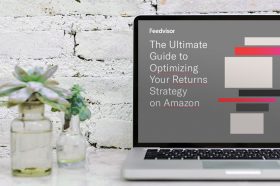Resources - Blog
How to Avoid, Minimize, and Address Amazon A-Z Claims

Amazon is deeply rooted in robust customer centricity. The company puts significant trust in their customers’ opinions, which in turn allows them to innovate and evolve. Given that Amazon is so focused on the customer experience, it is your responsibility as marketplace sellers and brands to take this into account as you sell products across Amazon’s platform. Having a reputation management strategy will help your defense significantly when it comes to various seller problems, such as dealing with A-Z Guarantee Claims.
Amazon’s A-Z Guarantee gives customers confidence when they purchase items sold and fulfilled by you directly. It covers both the on-time delivery and condition of the items you sell. If customers are unsatisfied with either of these variables, they are able to report the problem to Amazon via a self-service experience or a call to Amazon customer service, and can then file a claim to get their money back.
The claim is then investigated by Amazon, who will reach out to you if they need more information before coming to a decision. You are expected to respond within three calendar days or run the risk of losing the claim to the customer and paying the claim amount. Amazon notifies you and the customer about the claim decision via email.
What Is an Amazon A-Z Guarantee Claim?
Customers have 90 days from the estimated delivery date of their product to file an A-Z Guarantee Claim. The A-Z Guarantee Claim allows customers protection for specific scenarios and guarantees either a refund or partial refund to buyers if:
1. The item never arrives, or it arrives three days after the latest estimated delivery date or 30 days from the order date — whichever is sooner.
2. The item is damaged, defective, misclassified, misrepresented, or is missing parts.
3. The customer has returned an item but hasn’t received the refund from the seller.
4. The seller hasn’t accepted a return request according to Amazon’s return policy.
5. The customer wants to return an international order and the seller has not provided a return address, a prepaid label, or a full refund without the item being returned.
Avoiding A-Z Claims are especially important, as your order defect rate (ODR) may be negatively impacted, and this metric impacts Buy Box share. Order defect rate is a combination of three different metrics — the negative feedback rate, the A-Z Guarantee claim rate, and the service chargeback rate. Amazon combines these three numbers to get the percentage of the defective orders that were sent.
It groups these orders into two categories, short-term — orders placed between one and two months ago, and long-term — those placed between one and four months ago. Orders placed in the last 17 days are disregarded, as not enough time has passed to gather enough customer complaints.
Buyers may only submit their claims to Amazon’s A-Z Guarantee program 30 calendar days after the order date, and, generally speaking, claims should not be made after 90 days after the order date. Exceptions include when the seller can issue an immediate refund for an unreceived or unsatisfactory order, and prevent the claim altogether, as per the instructions on the Managing Refunds page.
If a buyer enters a warranty claim against you, Amazon notifies you right away. You may obtain the information regarding registered claims by using the A-to-Z Guarantee link within your individual accounts. You do have the ability to appeal an A-Z Guarantee claim within 30 calendar days of the decision. If you win, your account will be credited for the amount of the claim and your ODR will no longer be impacted.
Defining a “Significant Difference”
Missing, broken, or unusable parts are covered by this guarantee, as is an incorrect version listing (for example, special edition vs. regular edition, version 2.1 vs. version 2.0, etc.).
Most commonly, a “significant difference” between a given product listing and the product received by the buyer is an inaccurate description of the product. If you manipulate or falsify a product’s description to the extent that the worth of condition of the item is misrepresented, then Amazon’s A-to-Z Guarantee would apply, since buyers must be able to rely on the descriptions that inform their decisions to buy.
Item descriptions detail the given product’s features, condition, and so on. You are therefore encouraged to provide honest and precise information for all products listed.
However, products that are listed and described accurately, are received by the buyer in a timely way, and arrive undamaged and complete, are not covered by the A-to-Z Guarantee. If buyers regret their purchases and suffer from the traditional “buyer’s remorse,” you are left to your own discretion regarding product returns and refunds.
Stay on top of the latest e-commerce and marketplace trends.
How to Prevent Claims
Here are a few key recommendations and proactive measures to avoid and minimize A-Z Guarantee Claims:
1. Optimize your shipping processes and product packaging.
Be sure to purchase tracking for your shipments. This will allow customers to check in on the status of their shipment without having to contact you. If you do not provide tracking, your valid tracking rate can be impacted, another metric that can affect your Buy Box share. You should also purchase signature confirmation for valuable shipments, which provides an added layer of protection for both you and the customer.
Next, package your products carefully and add extra packaging if your items are fragile or are arriving to the customers with damage. Lastly, you should confirm your shipments on time according to their expected ship date. If you do not ship on time, your late shipment rate can be impacted, which is another metric that can affect your chances of winning the Buy Box.
2. Be specific with your product descriptions.
You should be sure to match your listings against the right Amazon Standard Identification Number (ASIN) and confirm that it is listed in the right condition. For example, do not list a second-hand or used item as new. The title of your item should include information such as brand, product line, color, size, material or key feature, and packaging or quantity and order them in a way that places the most relevant keywords first.
Including listing bullets are another way to optimize your product listing page, and will in turn aid relevance and conversion. Well-written product descriptions should tell a story and relay a sense of urgency via a compelling call to action.
Having multiple clear, high-resolution product images will help your rank in the search results. Customers want to be able to see the product from multiple angles, be able to zoom in, and see it in use or worn depending on what it is. You should use a white background with clear lighting, make sure that the main image fills at least 80% of the frame, highlights product benefits and uses, clearly shows your brand if you are selling private label items, and is at least 1000×1000 pixels for zoom capability. Lastly, be quick to cancel any out-of-stock orders — let the customers know why you canceled their orders so they are not waiting for their items to arrive.
3. Respond to emails in a timely manner.
Make a conscious effort to respond to customer inquiries within 24 hours to ensure a seamless customer experience. You can also refund customers proactively — if they contact you for a refund, move forward with the process to avoid them filing a claim.
Be Proactive to Mitigate Risk
You are strongly advised to respond immediately to buyers’ communications in the hopes of preventing any and all claims filed against you. Delays in response time increase the likelihood of blame falling on you.
If you have more than one claim per 100 orders, your account may be at risk for review or suspension from Amazon, so you should be particularly mindful of your fulfillment model, your response time, and the accuracy of your listings. Closely analyze your business model to be sure that you are being proactive whenever possible and keeping the customer first at all stages of the selling process.
Learn what Feedvisor can do for your business.
When you partner with Feedvisor, you automatically receive access to our true, AI-driven technology and hands-on team of e-commerce experts. Contact one of our team members today to learn more about our end-to-end solution for brands and large sellers on Amazon, Walmart, and e-marketplaces.



